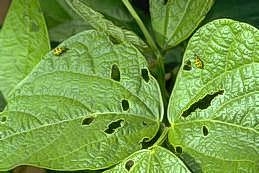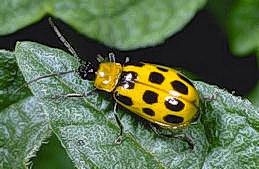Last weekend I went out to my back porch to water and deadhead my container garden and came across some damage to my cosmos. The petals of most of the flowers had multiple small holes. I looked more carefully and noticed that the tomato plant next to the cosmos also had small holes in the leaves and in the fruit. Now I was curious! What was causing this damage to my plants? As I started turning over leaves and rotating tomato fruits, I spotted what looked like a yellow ladybug. A-ha! A potential pest! But who was this spotted critter?

As is indicated in the common name, Western spotted cucumber beetles and cucumber beetles in general are common on cucurbits, that is melons and cucumbers. But they also will feed on other tender succulent portions of garden plants, including the flowers and leaves. The life cycle includes several generations a year, with eggs laid at the base of plants or in soil cracks, larvae which burrow into the soil and eat plant roots, and adult beetles that attack the aboveground portions of plants. Adult beetles are shiny with black heads, long antennae, and yellowish bodies with black spots. There's also a related striped cucumber beetle that has stripes rather than spots, but does pretty similar damage in the garden.

For more information, check out the UCANR Integrated Pest Management information here and here. Don't forget to subscribe to our blog so that you receive an email notification when a new post goes up. If you have questions, contact us online, by phone or in person to get answers to your gardening quandaries!